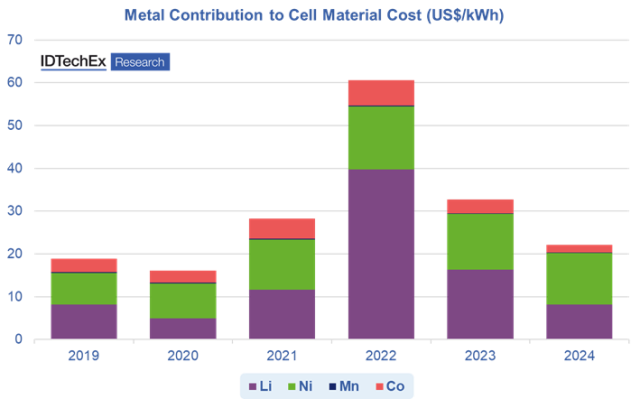The size of the lithium-ion battery market will become more than $400 billion by 2035, according to a recent report from IDTechEx.
Alex Holland, Research Director at IDTechEx, highlights that falling battery costs, driven by raw material price fluctuations and technological advancements, will play a major role in shaping the future of this market.
Material Costs Drive Battery Prices
Lithium, nickel, cobalt, and graphite are the core components of lithium-ion (Li-ion) batteries, and their price trends significantly impact the overall cost of battery production. In 2022, the prices of these materials spiked due to increased demand, particularly for lithium, which added up to $60/kWh to the cost of certain battery chemistries. However, by 2023, prices began to stabilize, and the raw materials now contribute only around $20/kWh in 2024. This stabilization has helped to lower the overall cost of Li-ion batteries, making them more affordable for consumers and manufacturers alike.
Competitive Market
The report notes the competition in the Li-ion battery market, particularly for LFP (lithium iron phosphate) batteries, which are popular due to their lower cost compared to NMC (nickel, manganese, cobalt) chemistries. In 2022, rising demand, especially in China, led to an unexpected price hike for LFP cathodes. This resulted in increased production capacity in China, and by 2024, prices dropped to $5/kg, squeezing producer margins.
While lower prices benefit consumers, they pose challenges for companies trying to enter or expand in the market. New entrants face stiff competition from established players with larger scale production and cost advantages, especially those based in China and Asia. European and North American battery manufacturers, such as Northvolt, have found it difficult to scale up production quickly, while electric vehicle (EV) manufacturers in these regions are concerned about the influx of low-cost EVs from China, driven in part by cheap LFP batteries.
Policy Support and Technological Advancements
Despite these challenges, the industry remains optimistic about outlook for the Li-ion battery market. Broad policy support for EVs and renewable energy continues to create strong demand for Li-ion batteries. Government initiatives like the U.S. Inflation Reduction Act and emissions performance standards in Europe are expected to maintain stable demand for EVs outside of China.
Technological innovations, such as solid-state batteries, silicon anodes, and advanced battery management systems, are improving battery performance by offering higher energy density, faster charging times, and longer lifespans. These advancements will help enhance the overall value proposition of battery-powered EVs and energy storage systems, even if achieving lower costs than current LFP prices may be difficult.
Conclusion
While the global Li-ion battery market is expected to grow significantly, material prices and supply-demand dynamics will continue to shape its evolution. Low prices benefit consumers but create challenges for new entrants and regional manufacturers. The market remains buoyed by strong policy support and ongoing technological innovation, ensuring continued demand for high-performance batteries across sectors like electric vehicles and renewable energy.

